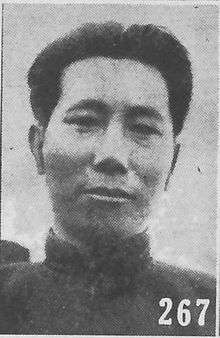Serengdongrub
Serengdongrub (Mongolian: ᠰᠡᠷᠡᠩᠳᠣᠩᠷᠣᠪ; 17 February 1894 – 2 August 1980) was an Inner Mongolian politician in the Republic of China.[2] An ethnic Mongol, he was a native of Harqin Middle Banner (today Ningcheng County, Chifeng).[3]

Names
His Mongolian name Serengdongrub (also spelled Serendonrub, Serengdongrob, Serengdonrov, etc.) was transcribed into Chinese characters as Chinese: 色楞棟魯布; pinyin: Sèléngdònglǔbù.[3] In the Mongolian Cyrillic alphabet, it is written Сэрэндонров (Serendonrov).[4] He used the Chinese name Pai Yün-t'i (Chinese: 白雲梯; pinyin: Bái Yúntī), and the courtesy name Chü Ch'uan (Chinese: 巨川; pinyin: Jù Chuān).[3] Some scholars read his Chinese name as a transcription of another Mongolian name Buyantai (meaning "meritorious", in Cyrillic Буянтай), and conflate references to Serengdongrub and Buyantai; however, as Christopher Atwood points, Buyantai (布彦泰) was actually another Harqin Mongol, whose Chinese name was Yu Lanzhai or Yu Lanze (??择).[5]
Career
In 1912, he entered the Mongolian and Tibetan School at Beijing under Gungsangnorbu. Afterwards he joined the Kuomintang. In 1925, he was one of the founders of the Inner Mongolian People's Revolutionary Party, along with Merse. In 1934, he became a member of the Mongol Local Autonomy Political Affairs Committee. From 1948 to 1949 he served as head of the Mongolian and Tibetan Affairs Commission. He retreated to Taiwan with the KMT, and died there in 1980.[2]
References
- Asahi Shimbun 1941
- Hsueh 2004
- "近代蒙古族历史人物 — Important figures in modern Mongolian history", Xinhua News, 2005, retrieved 2011-08-04
- Jamsran & Bayasakh 1997, pp. 193–194
- Atwood 2000, p. 97
Bibliography
- Atwood, Christopher (April 2000), "Inner Mongolian Nationalism in the 1920s: A Survey of Documentary Information", Twentieth-Century China, 25 (2): 75–113
- 薛化元 — Hsueh Hua-yuan (2005), "白雲梯", 臺灣歷史辭典 — Taiwan Historical Dictionary, Taipei: National Repository of Cultural Heritage, archived from the original on 2012-03-22, retrieved 2011-08-05
- L. Jamsran; J. Bayasakh (1997), Монголын төрийн тусгаар тогтнолын сэргэлт — Study on the Mongolian struggle for freedom, Mongolian Academy of Science, OCLC 41649537
- 最新支那要人伝 — Newest Bibliographies of Important Figures in China, 朝日新聞社 — Asahi Shimbun Company, 1941, OCLC 23310651
Further reading
- Boorman, Howard L. (1967), "Buyantai", Biographical Dictionary of Republican China, Volume 1, Columbia University Press, pp. 6–9, OCLC 411998; however, note that Atwood 2000, p. 97 warns against reliance on this entry due to "massive errors of fact and interpretation", including the name under which it is filed.